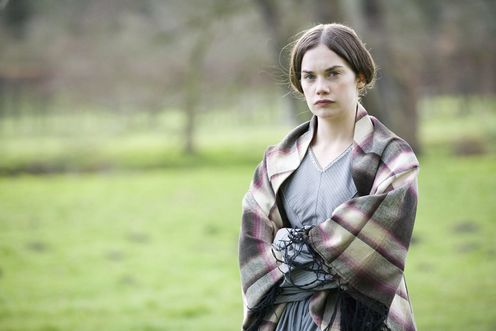Tuesday
I spent yesterday listening to our seniors present their St. Mary’s Projects, a two-semester independent study that English majors can opt to undertake. Kayla Waring, an English-Film double major whose project I mentored, explained why most film versions of Jane Eyre (1847)are disappointing, at least in her eyes.
As Kayla sees is, Jane Eyre has a quest plot that masquerades as a marriage plot. Her reading relies on the formulation of feminist theorist Rachael Blau DuPlessis, who argues that one couldn’t have both in the 19th century. If Bronte had not included a marriage romance, Kayla believes, her novel wouldn’t have been published, so one shouldn’t take “Reader, I married him” seriously. Instead, one should see the novel as a woman’s struggle for autonomy. Jane doesn’t seek marriage to be fulfilled.
Kayla also leans on Jody Bower’s argument that Jane Eyre has an “Aletis” or “wandering heroine” plot. This is in contrast with male quest plots, which have more clearly defined forward-trajectories.
In writing such a novel, Kayla argues that Bronte was courageously challenging the “horizon of expectations” of her time, which expected women to be docile and submissive hearth angels. According to reception theorist Hans Robert Jauss, whose ideas Kayla used, great works of literature challenge their age’s horizon while “culinary” works conform to them. Ultimately great works like Jane Eyre can change the horizon, but it sometimes takes a while.
Kayla notes that only a few of Bronte’s contemporaries understood how radical Jane Eyre was. Conservative Elizabeth Rigby did and accordingly hated the novel, calling it unfeminine, unchristian, and chartist (which is to say, communist). Kayla believes that Rigby, a successful journalist, feared that Jane Eyre would expose her own unfeminine ambitions and perhaps her own repressed anger.
While a number of men loved Jane Eyre, Kayla points out that they ignored Jane’s anger, most fully expressed through her alter ego Bertha Mason. Instead, like George Henry Lewes, they focused on angelic Helen Burns and on the marriage plot. Kayla believes it is necessary to adjust Jauss’s theory slightly: one may choose to misread a work to bring it in line with existing social expectations. That’s the downside of “Reader, I married him”: while it may have provided Bronte with cover, it also gave readers an escape hatch.
It was an escape hatch that most of the 20th century adaptations would take. In the 1943 Orson Welles version, for instance, Kayla notes that the job of Joan Fontaine’s Jane is to redeem the tormented Rochester. The 1943 Jane Eyre has a film noir aesthetic, which focuses on men fearful for their masculinity, and Fontaine must be a healing presence. Otherwise she would be a dangerous femme fatale.
Kayla believes that the 1996 Franco Zeffirelli version fails because, following the feminist revolution of the 1970s, it can no long fully commit to the marriage plot but it can’t fully commit to the quest plot either. Without a strong female protagonist or a strong love story, it has nothing to offer anyone and becomes gray mush.
Kayla’s favorite adaptation is the 2006 BBC television series, which focuses on Jane’s development as an individual and takes seriously her career as a teacher and school mistress. These plot aspects outweigh the fact that Jane gets married. Kayla notes that it’s the only version directed by a woman.
Kayla says that we’re not home free yet, however. In the 2011 Cary Fukunaga version, the film schizophrenically shifts from a strong independent Jane back to the marriage plot, testimony to the continuing box office demand for the latter. Fukunaga’s version is different from Zeffirelli’s only in that it tries to commit to both plots instead of neither.
Kayla, who does not herself want to be defined by marriage, says that Bronte was at least 160 years ahead of her time. And perhaps still counting.


